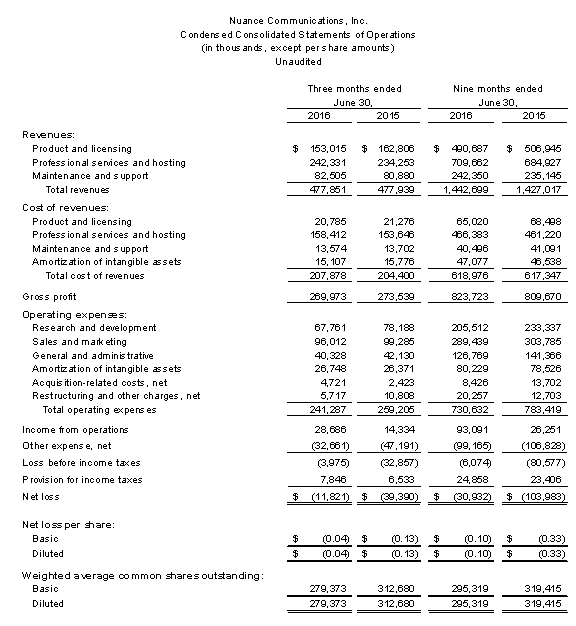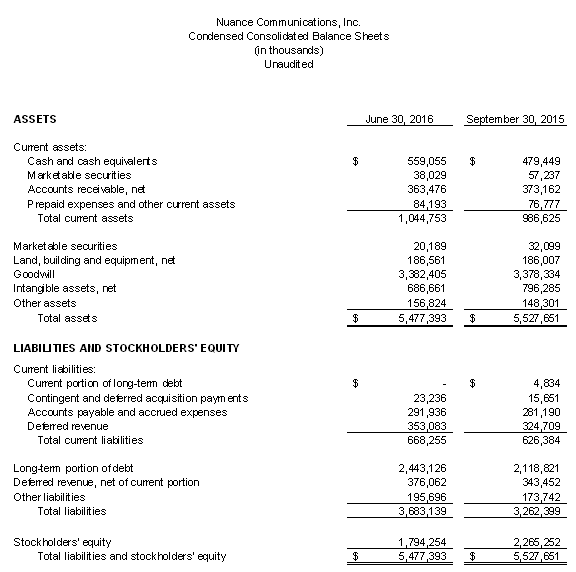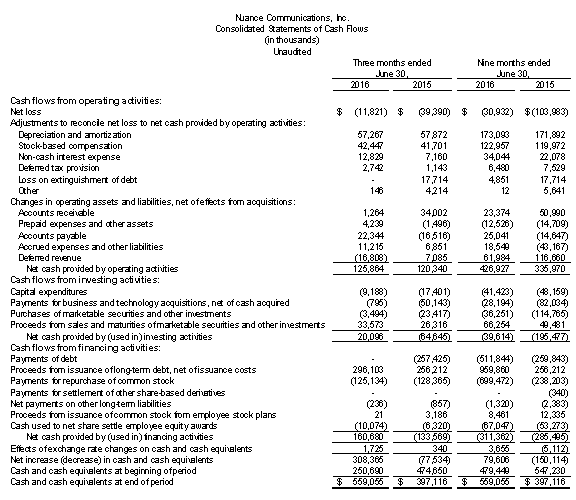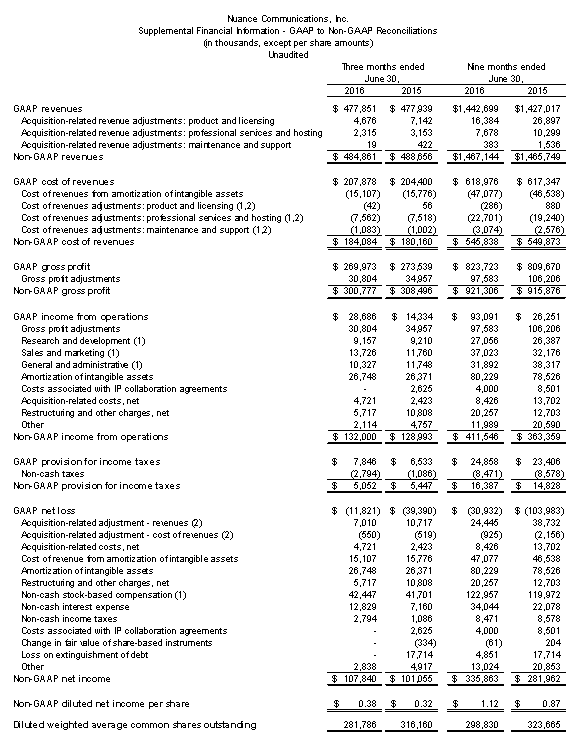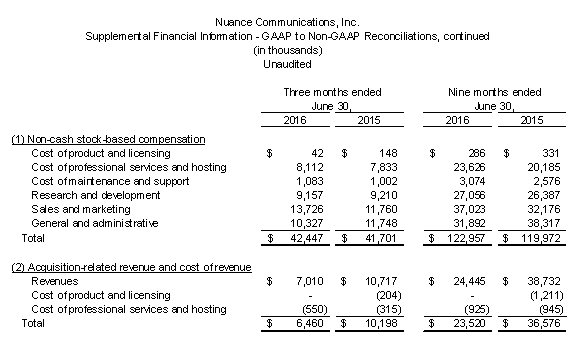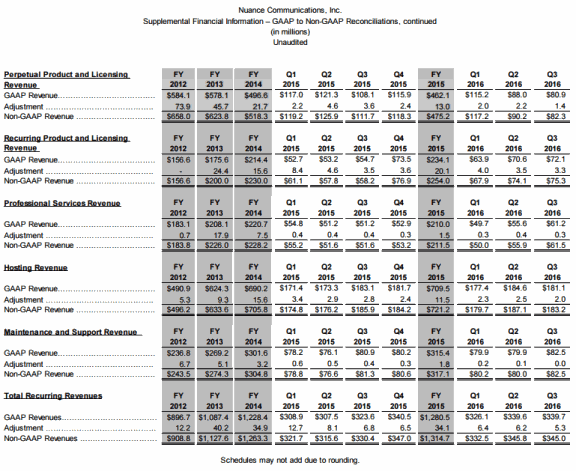BURLINGTON, Mass., August 8, 2016 –Nuance Communications, Inc. (NASDAQ: NUAN) today announced financial results for its third quarter fiscal 2016, ended June 30, 2016.
In the third quarter of fiscal 2016, Nuance reported GAAP revenue of $477.9 million, compared to $477.9 million a year ago. Nuance reported non-GAAP revenue of $484.9 million, which includes $7.0 million of revenue excluded from GAAP revenue due to accounting treatment in conjunction with acquisitions, as compared to $488.7 million in the third quarter of fiscal 2015. In the third quarter of 2016, recurring revenue was 71% of total revenue, compared to 68% a year ago, on both a GAAP and non-GAAP basis. In the third quarter of fiscal 2016, Nuance reported net new bookings of $362.9 million. This includes an expected decline from $484.4 million recorded in the third quarter of fiscal 2015 as the prior-year period included a significant automotive booking that caused bookings in that quarter to be unusually high.
In the third quarter of fiscal 2016, Nuance recognized GAAP net loss of $(11.8) million, or $(0.04) per share, compared to GAAP net loss of $(39.4) million, or $(0.13) per share, in the third quarter of fiscal 2015. Nuance reported non-GAAP net income of $107.8 million, or $0.38 per diluted share, up from non-GAAP net income of $101.1 million, or $0.32 per diluted share, in the third quarter of fiscal 2015. Nuance’s third quarter fiscal 2016 GAAP operating margin was 6.0%, up from 3.0% in the third quarter of fiscal 2015. Nuance’s third quarter fiscal 2016 non-GAAP operating margin was 27.2%, up from 26.4% in the third quarter of fiscal 2015. Nuance reported cash flow from operations of $125.9 million in the third quarter of fiscal 2016, up slightly from $120.3 million in the third quarter of fiscal 2015.
“Overall, we have delivered a solid performance in our third quarter and year-to-date 2016, particularly in our Enterprise segment and automotive business,” said Daniel Tempesta, Nuance CFO. “Balancing our continued initiatives to reduce costs and improve productivity with investments in our products and growth markets, we believe we are positioning the company for renewed growth and profitability.”
Please refer to the “Discussion of Non-GAAP Financial Measures” and to the “GAAP to Non-GAAP Reconciliations,” included elsewhere in this release, for more information regarding the company’s use of non-GAAP financial measures.
Conference Call and Prepared Remarks
Nuance will host an investor conference call today that will begin at 5:00 p.m. ET and will include only brief comments followed by questions and answers. To access the live broadcast, please visit the Investor Relations section of Nuance’s website at www.nuance.com. The call can also be heard by dialing 800-230-1092 or 612-288-0329 at least five minutes prior to the call and referencing code 398580. A replay will be available within 24 hours of the announcement by dialing 800-475-6701 or 320-365-3844 and using the access code 398580.
Nuance is providing a copy of prepared remarks in combination with its press release. These remarks are offered to provide shareholders and analysts with additional time and detail for analyzing results in advance of the company’s quarterly conference call. The remarks will be available at http://www.nuance.com/earnings-results/ in conjunction with the press release.
About Nuance Communications, Inc.
Nuance Communications, Inc. (NASDAQ: NUAN) is a leading provider of voice and language solutions for businesses and consumers around the world. Its technologies, applications and services make the user experience more compelling by transforming the way people interact with devices and systems. Every day, millions of users and thousands of businesses experience Nuance’s proven applications. For more information, please visit www.nuance.com.
Trademark reference: Nuance and the Nuance logo are registered trademarks or trademarks of Nuance Communications, Inc. or its affiliates in the United States and/or other countries. All other trademarks referenced herein are the property of their respective owners.
Definitions of Bookings and Net New Bookings
Bookings represent the estimated gross revenue value of transactions at the time of contract execution, except for maintenance and support offerings. For fixed price contracts, the bookings value represents the gross total contract value. For contracts where revenue is based on transaction volume, the bookings value represents the contract price multiplied by the estimated future transaction volume during the contract term, whether or not such transaction volumes are guaranteed under a minimum commitment clause. Actual results could be different than our initial estimates. The maintenance and support bookings value represents the amounts billed in the period the customer is invoiced. Because of the inherent estimates required to determine bookings and the fact that the actual resultant revenue may differ from our initial bookings estimates, we consider bookings one indicator of potential future revenue and not as an arithmetic measure of backlog.
Net new bookings represents the estimated revenue value at the time of contract execution from new contractual arrangements or the estimated revenue value incremental to the portion of value that will be renewed under pre-existing arrangements. Constant currency for net new bookings is calculated using current period net new bookings denominated in currencies other than United States dollars, converted into United States dollars using the average exchange rate for those currencies from the prior year period rather than the actual exchange rate in effect during the current period.
Safe Harbor and Forward-Looking Statements
Statements in this document regarding future performance and our management’s future expectations, beliefs, goals, plans or prospects constitute forward-looking statements within the meaning of the Private Securities Litigation Reform Act of 1995. Any statements that are not statements of historical fact (including statements containing the words “believes,” “plans,” “anticipates,” “expects,” or “estimates” or similar expressions) should also be considered to be forward-looking statements. There are a number of important factors that could cause actual results or events to differ materially from those indicated by such forward-looking statements, including but not limited to: fluctuations in demand for our existing and future products; changes to economic conditions in the United States and internationally; fluctuating currency rates, our ability to control and successfully manage our expenses and cash position; our ability to execute our formal transformation program to reduce costs and optimize processes; the effects of competition, including pricing pressure; possible quality issues in our products and technologies; our ability to successfully integrate operations and employees of acquired businesses; the conversion rate of bookings into revenue; the ability to realize anticipated synergies from acquired businesses; and, the other factors described in our annual report on Form 10-K for the fiscal year ended September 30, 2015, as supplemented by our current report on Form 8-K filed on May 11, 2016, our quarterly reports, and other reports we have filed with the Securities and Exchange Commission. We disclaim any obligation to update any forward-looking statements as a result of developments occurring after the date of this document.
The information included in this press release should not be considered superior to, or a substitute for, financial statements prepared in accordance with GAAP.
Discussion of Non-GAAP Financial Measures
We utilize a number of different financial measures, both Generally Accepted Accounting Principles (“GAAP”) and non-GAAP, in analyzing and assessing the overall performance of the business, for making operating decisions and for forecasting and planning for future periods. Our annual financial plan is prepared both on a GAAP and non-GAAP basis, and the non-GAAP annual financial plan is approved by our board of directors. Continuous budgeting and forecasting for revenue and expenses are conducted on a consistent non-GAAP basis (in addition to GAAP) and actual results on a non-GAAP basis are assessed against the non-GAAP annual financial plan. The board of directors and management utilize these non-GAAP measures and results (in addition to the GAAP results) to determine our allocation of resources. In addition and as a consequence of the importance of these measures in managing the business, we use non-GAAP measures and results in the evaluation process to establish management’s compensation. For example, our annual bonus program payments are based upon the achievement of consolidated non-GAAP revenue and consolidated non-GAAP earnings per share financial targets. We consider the use of non-GAAP revenue helpful in understanding the performance of our business, as it excludes the purchase accounting impact on acquired deferred revenue and other acquisition-related adjustments to revenue. We also consider the use of non-GAAP earnings per share helpful in assessing the organic performance of the continuing operations of our business. By organic performance we mean performance as if we had owned an acquired business in the same period a year ago. By constant currency organic performance we mean performance excluding the effect of current foreign currency rate fluctuations. By continuing operations we mean the ongoing results of the business excluding certain unplanned costs. While our management uses these non-GAAP financial measures as a tool to enhance their understanding of certain aspects of our financial performance, our management does not consider these measures to be a substitute for, or superior to, the information provided by GAAP financial statements. Consistent with this approach, we believe that disclosing non-GAAP financial measures to the readers of our financial statements provides such readers with useful supplemental data that, while not a substitute for GAAP financial statements, allows for greater transparency in the review of our financial and operational performance. In assessing the overall health of the business during the three and nine months ended June 30, 2016, our management has either included or excluded items in six general categories, each of which is described below.
Acquisition-Related Revenue and Cost of Revenue.
We provide supplementary non-GAAP financial measures of revenue, which include revenue related to acquisitions, primarily from Notable Solutions and Quantim for the three and nine months ended June 30, 2016 that we would have recognized but for the purchase accounting treatment of these transactions. Non-GAAP revenue also includes revenue that we would have recognized had we not acquired intellectual property and other assets from the same customer. Because GAAP accounting requires the elimination of this revenue, GAAP results alone do not fully capture all of our economic activities. These non-GAAP adjustments are intended to reflect the full amount of such revenue. We include non-GAAP revenue and cost of revenue to allow for more complete comparisons to the financial results of historical operations, forward-looking guidance and the financial results of peer companies. We believe these adjustments are useful to management and investors as a measure of the ongoing performance of the business because, although we cannot be certain that customers will renew their contracts, we have historically experienced high renewal rates on maintenance and support agreements and other customer contracts. Additionally, although acquisition-related revenue adjustments are non-recurring with respect to past acquisitions, we generally will incur these adjustments in connection with any future acquisitions.
Acquisition-Related Costs, Net.
In recent years, we have completed a number of acquisitions, which result in operating expenses which would not otherwise have been incurred. We provide supplementary non-GAAP financial measures, which exclude certain transition, integration and other acquisition-related expense items resulting from acquisitions, to allow more accurate comparisons of the financial results to historical operations, forward-looking guidance and the financial results of less acquisitive peer companies. We consider these types of costs and adjustments, to a great extent, to be unpredictable and dependent on a significant number of factors that are outside of our control. Furthermore, we do not consider these acquisition-related costs and adjustments to be related to the organic continuing operations of the acquired businesses and are generally not relevant to assessing or estimating the long-term performance of the acquired assets. In addition, the size, complexity and/or volume of past acquisitions, which often drives the magnitude of acquisition-related costs, may not be indicative of the size, complexity and/or volume of future acquisitions. By excluding acquisition-related costs and adjustments from our non-GAAP measures, management is better able to evaluate our ability to utilize our existing assets and estimate the long-term value that acquired assets will generate for us. We believe that providing a supplemental non-GAAP measure which excludes these items allows management and investors to consider the ongoing operations of the business both with, and without, such expenses.
These acquisition-related costs fall into the following categories: (i) transition and integration costs; (ii) professional service fees; and (iii) acquisition-related adjustments. Although these expenses are not recurring with respect to past acquisitions, we generally will incur these expenses in connection with any future acquisitions. These categories are further discussed as follows:
(i) Transition and integration costs. Transition and integration costs include retention payments, transitional employee costs, and earn-out payments treated as compensation expense, as well as the costs of integration-related activities, including services provided by third-parties.
(ii) Professional service fees and expenses. Professional service fees and expenses include financial advisory, legal, accounting and other outside services in connection with acquisition activities, and disputes and regulatory matters related to acquired entities.
(iii) Acquisition-related adjustments. Acquisition-related adjustments include items that are required to be marked to fair value each reporting period, such as contingent consideration, and other items related to acquisitions for which the measurement period has ended, such as gains or losses on settlements of pre-acquisition contingencies.
Amortization of Acquired Intangible Assets.
We exclude the amortization of acquired intangible assets from non-GAAP expense and income measures. These amounts are inconsistent in amount and frequency and are significantly impacted by the timing and size of acquisitions. Providing a supplemental measure which excludes these charges allows management and investors to evaluate results “as-if” the acquired intangible assets had been developed internally rather than acquired and, therefore, provides a supplemental measure of performance in which our acquired intellectual property is treated in a comparable manner to our internally developed intellectual property. Although we exclude amortization of acquired intangible assets from our non-GAAP expenses, we believe that it is important for investors to understand that such intangible assets contribute to revenue generation. Amortization of intangible assets that relate to past acquisitions will recur in future periods until such intangible assets have been fully amortized. Future acquisitions may result in the amortization of additional intangible assets.
Costs Associated with IP Collaboration Agreement.
In order to gain access to a third party's extensive speech recognition technology and natural language and semantic processing technology, we have entered into IP collaboration agreements, with terms ranging between five and six years. Depending on the agreement, some or all intellectual property derived from these collaborations will be jointly owned by the two parties. For the majority of the developed intellectual property, we will have sole rights to commercialize such intellectual property for periods ranging between two to six years, depending on the agreement. For non-GAAP purposes, we consider these long-term contracts and the resulting acquisitions of intellectual property from this third-party over the agreements’ terms to be an investing activity, outside of our normal, organic, continuing operating activities, and are therefore presenting this supplemental information to show the results excluding these expenses. We do not exclude from our non-GAAP results the corresponding revenue, if any, generated from these collaboration efforts. Although our bonus program and other performance-based incentives for executives are based on the non-GAAP results that exclude these costs, certain engineering senior management are responsible for execution and results of the collaboration agreement and have incentives based on those results. Costs associated with the research and development portion of the agreements have been excluded from research and development expense and costs for extending the marketing exclusivity period are excluded from sales and marketing expense.
Non-Cash Expenses.
We provide non-GAAP information relative to the following non-cash expenses: (i) stock-based compensation; (ii) certain accrued interest; and (iii) certain accrued income taxes. These items are further discussed as follows:
(i) Stock-based compensation. Because of varying valuation methodologies, subjective assumptions and the variety of award types, we believe that excluding stock-based compensation allows for more accurate comparisons of operating results to peer companies, as well as to times in our history when stock-based compensation was more or less significant as a portion of overall compensation than in the current period. We evaluate performance both with and without these measures because compensation expense related to stock-based compensation is typically non-cash and the options and restricted awards granted are influenced by the Company’s stock price and other factors such as volatility that are beyond our control. The expense related to stock-based awards is generally not controllable in the short-term and can vary significantly based on the timing, size and nature of awards granted. As such, we do not include such charges in operating plans. Stock-based compensation will continue in future periods.
(ii) and (iii) Certain accrued interest and income taxes. We also exclude certain accrued interest and certain accrued income taxes because we believe that excluding these non-cash expenses provides senior management, as well as other users of the financial statements, with a valuable perspective on the cash-based performance and health of the business, including the current near-term projected liquidity. These non-cash expenses will continue in future periods.
Other Expenses.
We exclude certain other expenses that result from unplanned events in order to measure operating performance and current and future liquidity both with and without these expenses. By providing this information, we believe management and the users of the financial statements are better able to understand the financial results of what we consider to be our organic, continuing operations. Included in these expenses are items such as restructuring charges, asset impairments and other charges (credits), net. These events are unplanned and arise outside of the ordinary course of continuing operations. These items include losses from extinguishing our convertible debt and adjustments from changes in fair value of share-based instruments relating to issuing our common stock with security price guarantees payable in cash. Other items such as consulting and professional services fees related to assessing strategic alternatives and our transformation program, and gains or losses on non-controlling strategic equity interests, are also excluded.
We believe that providing the non-GAAP information to investors, in addition to the GAAP presentation, allows investors to view the financial results in the way management views the operating results. We further believe that providing this information allows investors to not only better understand our financial performance, but more importantly, to evaluate the efficacy of the methodology and information used by management to evaluate and measure such performance.
Contact Information
For Investors
Richard Mack
Nuance Communications, Inc.
Tel: 781-565-5000
richard.mack@nuance.com
For Press
Rebecca Paquette
Nuance Communications, Inc.
Tel: 781-565-5000
rebecca.paquette@nuance.com
Financial Tables Follow
